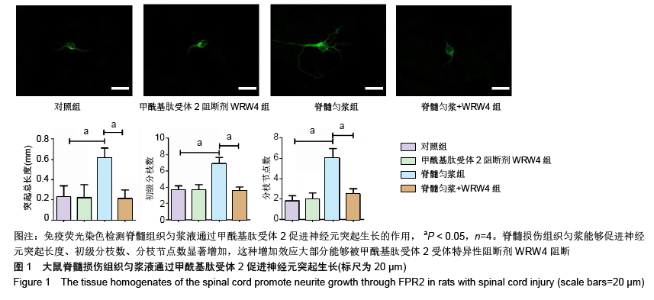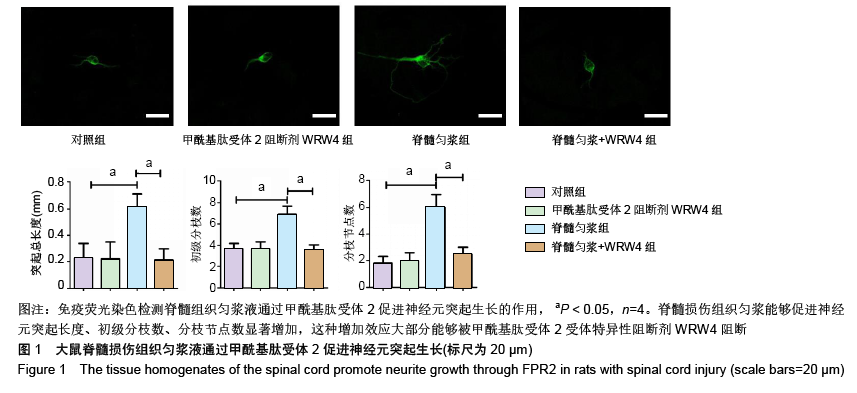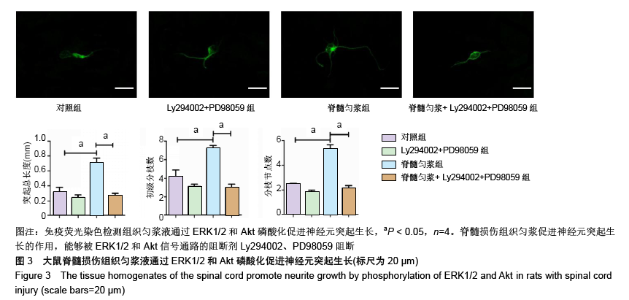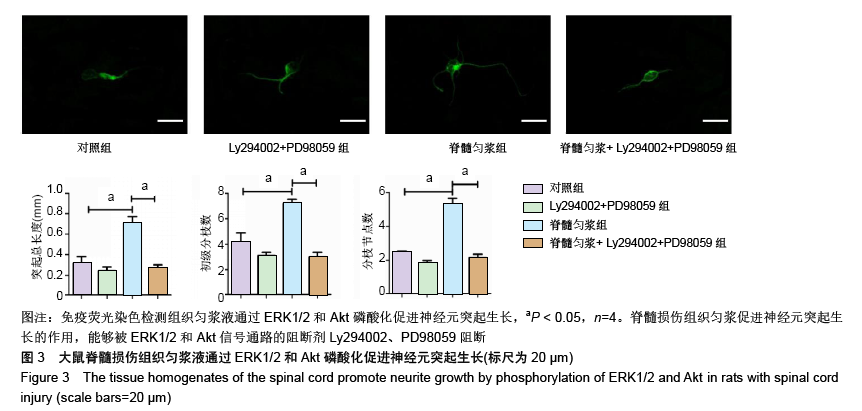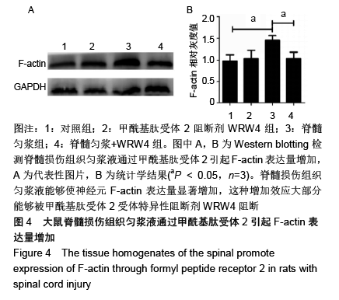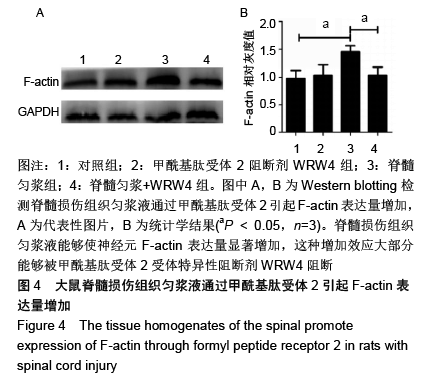Chinese Journal of Tissue Engineering Research ›› 2020, Vol. 24 ›› Issue (1): 106-111.doi: 10.3969/j.issn.2095-4344.1868
Previous Articles Next Articles
Spinal cord homogenate promotes neurite outgrowth through activation of formyl peptide receptor 2 after spinal cord injury
Zhang Liang1, Liu Mingyong1, Liu Peng1, Xue Xin1, Chen Zongfeng1, Zhang Liangmin1, Zhang Jian1, Guo Qiaonan2, Zhao Jianhua1
- 1Department of Spine Surgery, Daping Hospital, Army Medical University, Chongqing 400042, China; 2Department of Pathology, Xinqiao Hospital, Army Medical University, Chongqing 400037, China
-
Received:2019-02-15Revised:2019-02-23Accepted:2019-04-12Online:2020-01-08Published:2019-12-12 -
Contact:Zhang Liang, Department of Spine Surgery, Daping Hospital, Army Medical University, Chongqing 400042, China -
About author:Zhang Liang, MD, Associate chief physician, Department of Spine Surgery, Daping Hospital, Army Medical University, Chongqing 400042, China -
Supported by:the Scientific Research Fund for Health and Family Planning in Hubei Province, No. WJ2015MB228
CLC Number:
Cite this article
Zhang Liang, Liu Mingyong, Liu Peng, Xue Xin, Chen Zongfeng, Zhang Liangmin, Zhang Jian, Guo Qiaonan, Zhao Jianhua. Spinal cord homogenate promotes neurite outgrowth through activation of formyl peptide receptor 2 after spinal cord injury[J]. Chinese Journal of Tissue Engineering Research, 2020, 24(1): 106-111.
share this article
Add to citation manager EndNote|Reference Manager|ProCite|BibTeX|RefWorks
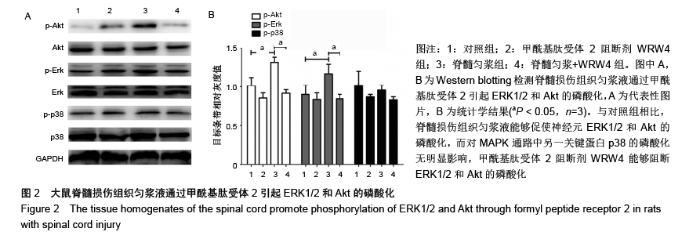
2.2 大鼠脊髓损伤组织匀浆液通过甲酰基肽受体2引起ERK1/2和Akt的磷酸化 为了探究甲酰基肽受体2激活对轴突生长促进作用的相关信号通路,实验检测了甲酰基肽受体2激活对MAPK和PI3K/Akt通路中关键蛋白磷酸化作用的影响。Western blotting实验结果提示:与对照组相比,脊髓匀浆液能够促使神经元中ERK1/2和Akt的磷酸化,而对MAPK通路中另一关键蛋白p38的磷酸化无明显影响,见图2;相反,利用甲酰基肽受体2受体特异性阻断剂WRW4进行阻断,发现不论是ERK1/2还是Akt的磷酸化都显著下降。这些实验结果说明,甲酰基肽受体2激活通过磷酸化ERK1/2和Akt促进轴突生长。"
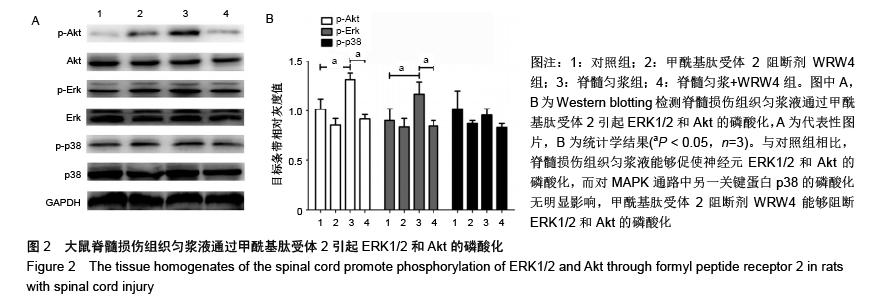
| [1] NEGRO S, LESSI F, DUREGOTTI E, et al. CXCL12α/SDF-1 from perisynaptic Schwann cells promotes regeneration of injured motor axon terminals. EMBO Mol Med. 2017;9(8):1000-1010. [2] DENG QJ, XU XF, REN J. Effects of SDF-1/CXCR4 on the Repair of Traumatic Brain Injury in Rats by Mediating Bone Marrow Derived Mesenchymal Stem Cells. Cell Mol Neurobiol. 2018;38(2):467-477. [3] CHENG X, WANG H, ZHANG X, et al. The Role of SDF-1/CXCR4/ CXCR7 in Neuronal Regeneration after Cerebral Ischemia. Front Neurosci. 2017;11: 590. [4] STEWART AN, MATYAS JJ, WELCHKO RM, et al. SDF-1 overexpression by mesenchymal stem cells enhances GAP-43-positive axonal growth following spinal cord injury. Restor Neurol Neurosci. 2017; 35(4):395-411. [5] ZHANG L, WANG G, CHEN X, et al. Formyl peptide receptors promotes neural differentiation in mouse neural stem cells by ROS generation and regulation of PI3K-AKT signaling. Sci Rep. 2017;7(1):206. [6] KORIMOVÁ A, KLUSÁKOVÁ I, HRADILOVÁ-SVÍŽENSKÁ I, et al. Mitochondrial Damage-Associated Molecular Patterns of Injured Axons Induce Outgrowth of Schwann Cell Processes. Front Cell Neurosci. 2018;12:457. [7] GENSEL JC, NAKAMURA S, GUAN Z, et al. Macrophages promote axon regeneration with concurrent neurotoxicity. J Neurosci. 2009;29(12): 3956-3968. [8] GAO JL, CHEN H, FILIE JD, et al. Differential expansion of the N-formylpeptide receptor gene cluster in human and mouse. Genomics. 1998;51(2):270-276. [9] BAO L, GERARD NP, EDDY RL JR, et al. Mapping of genes for the human C5a receptor (C5AR), human FMLP receptor (FPR), and two FMLP receptor homologue orphan receptors (FPRH1, FPRH2) to chromosome 19. Genomics. 1992;13(2):437-440. [10] MURPHY PM, OZÇELIK T, KENNEY RT, et al. A structural homologue of the N-formyl peptide receptor. Characterization and chromosome mapping of a peptide chemoattractant receptor family. J Biol Chem. 1992;267(11): 7637-7643. [11] YE RD, CAVANAGH SL, QUEHENBERGER O, et al. Isolation of a cDNA that encodes a novel granulocyte N-formyl peptide receptor. Biochem Biophys Res Commun. 1992;184(2):582-589. [12] CHENG TY, WU MS, LIN JT, et al. Annexin A1 is associated with gastric cancer survival and promotes gastric cancer cell invasiveness through the formyl peptide receptor/extracellular signal-regulated kinase/integrin beta-1-binding protein 1 pathway. Cancer. 2012;118(23):5757-5767. [13] BIZZARRO V, BELVEDERE R, MILONE MR, et al. Annexin A1 is involved in the acquisition and maintenance of a stem cell-like/ aggressive phenotype in prostate cancer cells with acquired resistance to zoledronic acid. Oncotarget. 2015;6(28):25076-25092. [14] KHAU T, LANGENBACH SY, SCHULIGA M, et al. Annexin-1 signals mitogen-stimulated breast tumor cell proliferation by activation of the formyl peptide receptors (FPRs) 1 and 2. FASEB J. 2011;25(2):483-496. [15] CHIANG N, SERHAN CN, DAHLÉN SE, et al. The lipoxin receptor ALX: potent ligand-specific and stereoselective actions in vivo. Pharmacol Rev. 2006;58(3):463-487. [16] YING G, IRIBARREN P, ZHOU Y, et al. Humanin, a newly identified neuroprotective factor, uses the G protein-coupled formylpeptide receptor-like-1 as a functional receptor. J Immunol. 2004;172(11): 7078-7085. [17] HE R, SANG H, YE RD. Serum amyloid A induces IL-8 secretion through a G protein-coupled receptor, FPRL1/LXA4R. Blood. 2003;101(4): 1572-1581. [18] HE N, JIN WL, LOK KH, et al. Amyloid-β(1-42) oligomer accelerates senescence in adult hippocampal neural stem/progenitor cells via formylpeptide receptor 2. Cell Death Dis. 2013;4:e924. [19] RESNATI M, PALLAVICINI I, WANG JM, et al. The fibrinolytic receptor for urokinase activates the G protein-coupled chemotactic receptor FPRL1/LXA4R. Proc Natl Acad Sci U S A. 2002;99(3):1359-1364. [20] LIU M, CHEN K, YOSHIMURA T, et al. Formylpeptide receptors mediate rapid neutrophil mobilization to accelerate wound healing. PLoS One. 2014;9(6):e90613. [21] 张良,程惠,冷明昊,等.甲酰基肽受体对神经干/袓细胞向类神经元分化的影响[J].中国组织工程研究,2018,22(1):107-122. [22] LIU M, CHEN K, YOSHIMURA T, et al. Formylpeptide receptors are critical for rapid neutrophil mobilization in host defense against Listeria monocytogenes. Sci Rep. 2012;2:786. [23] YOUSEFIFARD M, RAHIMI-MOVAGHAR V, NASIRINEZHAD F, et al. Neural stem/progenitor cell transplantation for spinal cord injury treatment; A systematic review and meta-analysis. Neuroscience. 2016;322:377-397. [24] RABIET MJ, HUET E, BOULAY F. Human mitochondria-derived N-formylated peptides are novel agonists equally active on FPR and FPRL1, while Listeria monocytogenes-derived peptides preferentially activate FPR. Eur J Immunol. 2005;35(8):2486-2495. [25] MARASCO WA, PHAN SH, KRUTZSCH H, et al. Purification and identification of formyl-methionyl-leucyl-phenylalanine as the major peptide neutrophil chemotactic factor produced by Escherichia coli. J Biol Chem. 1984; 259(9):5430-5439. [26] BETTEN A, BYLUND J, CHRISTOPHE T, et al. A proinflammatory peptide from Helicobacter pylori activates monocytes to induce lymphocyte dysfunction and apoptosis. J Clin Invest. 2001;108(8): 1221-1228. [27] DENG X, UEDA H, SU SB, et al. A synthetic peptide derived from human immunodeficiency virus type 1 gp120 downregulates the expression and function of chemokine receptors CCR5 and CXCR4 in monocytes by activating the 7-transmembrane G-protein-coupled receptor FPRL1/ LXA4R. Blood. 1999;94(4):1165-1173. [28] GEHRMANN J, MATSUMOTO Y, KREUTZBERG GW. Microglia: intrinsic immuneffector cell of the brain. Brain Res Brain Res Rev. 1995; 20(3): 269-287. [29] LE Y, MURPHY PM, WANG JM. Formyl-peptide receptors revisited. Trends Immunol. 2002;23(11):541-548. [30] SHIN MK, JANG YH, YOO HJ, et al. N-formyl-methionyl-leucyl- phenylalanine (fMLP) promotes osteoblast differentiation via the N-formyl peptide receptor 1-mediated signaling pathway in human mesenchymal stem cells from bone marrow. J Biol Chem. 2011;286(19):17133-17143. [31] ALAM A, LEONI G, WENTWORTH CC, et al. Redox signaling regulates commensal-mediated mucosal homeostasis and restitution and requires formyl peptide receptor 1. Mucosal Immunol. 2014;7(3):645-655. [32] JANG IH, HEO SC, KWON YW, et al. Role of formyl peptide receptor 2 in homing of endothelial progenitor cells and therapeutic angiogenesis. Adv Biol Regul. 2015;57:162-172. [33] BECKER EL, FOROUHAR FA, GRUNNET ML, et al. Broad immunocytochemical localization of the formylpeptide receptor in human organs, tissues, and cells. Cell Tissue Res. 1998;292(1):129-135. [34] WANG G, ZHANG L, CHEN X, et al. Formylpeptide Receptors Promote the Migration and Differentiation of Rat Neural Stem Cells. Sci Rep. 2016;6: 25946. [35] ZHANG C, WANG ZJ, LOK KH, et al. β-amyloid42 induces desensitization of CXC chemokine receptor-4 via formyl peptide receptor in neural stem/progenitor cells. Biol Pharm Bull. 2012;35(2):131-138. [36] HO CF, ISMAIL NB, KOH JK, et al. Localisation of Formyl-Peptide Receptor 2 in the Rat Central Nervous System and Its Role in Axonal and Dendritic Outgrowth. Neurochem Res. 2018;43(8):1587-1598. |
| [1] | Min Youjiang, Yao Haihua, Sun Jie, Zhou Xuan, Yu Hang, Sun Qianpu, Hong Ensi. Effect of “three-tong acupuncture” on brain function of patients with spinal cord injury based on magnetic resonance technology [J]. Chinese Journal of Tissue Engineering Research, 2021, 25(在线): 1-8. |
| [2] | Jiang Hongying, Zhu Liang, Yu Xi, Huang Jing, Xiang Xiaona, Lan Zhengyan, He Hongchen. Effect of platelet-rich plasma on pressure ulcers after spinal cord injury [J]. Chinese Journal of Tissue Engineering Research, 2021, 25(8): 1149-1153. |
| [3] | Wan Ran, Shi Xu, Liu Jingsong, Wang Yansong. Research progress in the treatment of spinal cord injury with mesenchymal stem cell secretome [J]. Chinese Journal of Tissue Engineering Research, 2021, 25(7): 1088-1095. |
| [4] | Xie Wenjia, Xia Tianjiao, Zhou Qingyun, Liu Yujia, Gu Xiaoping. Role of microglia-mediated neuronal injury in neurodegenerative diseases [J]. Chinese Journal of Tissue Engineering Research, 2021, 25(7): 1109-1115. |
| [5] | Kong Desheng, He Jingjing, Feng Baofeng, Guo Ruiyun, Asiamah Ernest Amponsah, Lü Fei, Zhang Shuhan, Zhang Xiaolin, Ma Jun, Cui Huixian. Efficacy of mesenchymal stem cells in the spinal cord injury of large animal models: a meta-analysis [J]. Chinese Journal of Tissue Engineering Research, 2021, 25(7): 1142-1148. |
| [6] | Zhu Xuefen, Huang Cheng, Ding Jian, Dai Yongping, Liu Yuanbing, Le Lixiang, Wang Liangliang, Yang Jiandong. Mechanism of bone marrow mesenchymal stem cells differentiation into functional neurons induced by glial cell line derived neurotrophic factor [J]. Chinese Journal of Tissue Engineering Research, 2021, 25(7): 1019-1025. |
| [7] | Wang Feng, Zhou Liyu, Saijilafu, Qi Shibin, Ma Yanxia, Wei Shanwen. CaMKII-Smad1 promotes axonal regeneration of peripheral nerves [J]. Chinese Journal of Tissue Engineering Research, 2021, 25(7): 1064-1068. |
| [8] | Xie Yang, Zhang Shujiang, Liu Menglan, Luo Ying, Yang Yang, Li Zuoxiao. Mechanism by which rapamycin protects spinal cord neurons in experimental autoimmune encephalomyelitis mice [J]. Chinese Journal of Tissue Engineering Research, 2021, 25(5): 695-700. |
| [9] | Ma Binxiang, He Wanqing, Zhou Guangchao, Guan Yonglin. Triptolide improves motor dysfunction in rats following spinal cord injury [J]. Chinese Journal of Tissue Engineering Research, 2021, 25(5): 701-706. |
| [10] | Su Liping, Lu Ziyang, Liu Li, Zhang Wei, Su Tianyuan, Hu Xiayun, Pu Hongwei, Han Dengfeng. C-jun, Cytc and Caspase-9 in the apoptosis of cerebellar granule neurons induced by diacetylmorphine in rats [J]. Chinese Journal of Tissue Engineering Research, 2021, 25(25): 3943-3948. |
| [11] | Sun Jianwei, Yang Xinming, Zhang Ying. Effect of montelukast combined with bone marrow mesenchymal stem cell transplantation on spinal cord injury in rat models [J]. Chinese Journal of Tissue Engineering Research, 2021, 25(25): 3962-3969. |
| [12] | Xu Weilong, Zuo Yuan, Xin Daqi, He Chenyang, Zhao Peng, Shi Ming, Zhou Boyuan, Liu Yating, Zhao Yan. Selection of modeling methods for acute compressive spinal cord injury: a network Meta-analysis [J]. Chinese Journal of Tissue Engineering Research, 2021, 25(23): 3767-3772. |
| [13] | Yan Peng, Ma Yufei, Cui Jingfu, Hao Shaofei, Liu Jinhui, Guan Chunlei, Wang Xiaoran, Yang Xiaoyu. Mechanism of anodic block electrical stimulation of sacral nerve root to reconstruct bladder function [J]. Chinese Journal of Tissue Engineering Research, 2021, 25(23): 3684-3689. |
| [14] | Chen Xinling, Wang Shenglan. Cell autophagy, pathway, regulation and its multiple correlations with pulmonary hypertension [J]. Chinese Journal of Tissue Engineering Research, 2021, 25(2): 311-316. |
| [15] | Tian Ting, Li Xiaoguang. Problems and challenges in regeneration and repair of spinal cord injury [J]. Chinese Journal of Tissue Engineering Research, 2021, 25(19): 3039-3048. |
| Viewed | ||||||
|
Full text |
|
|||||
|
Abstract |
|
|||||
